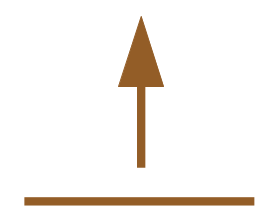The properties of the powers of x (for natural exponents)
Let \( n\in \mathbb{N}\) be natural number and \( x \in \mathbb{R}\) a real number.
We call \(x^n\) a number \(x\) multiplied \(n\) times by itself:
$$ x^n = \hspace{0.2em} \underbrace {x \times x \times x \times x \times x ...} _\text{ \(n\) factors } $$
All these formulas are demonstrated only for natural exponents \((n \in \mathbb{N})\).
Product/quotient of powers
Number to the power of zero
$$ \forall x \in \hspace{0.05em} \mathbb{R}^*, $$
$$ x^0 = 1 $$
Inverse of a power
$$ \forall x \in \hspace{0.05em} \mathbb{R^*}, \ \forall a \in \hspace{0.05em} \mathbb{N}, $$
$$\frac{1}{x^a} = x^{-a}$$
Power of a product/quotient
Power of a power
$$ \forall x \in \hspace{0.03em} \mathbb{R}, \ \forall (a, b) \in \hspace{0.03em} \mathbb{N}^2, $$
$$ (x^a)^b = (x^b)^a = x^{ab} $$
Recap table of the formulas of the powers of x
Démonstrations
-
Product
Let \( x\in \hspace{0.05em} \mathbb{R} \) a real number and \( (a, b) \in \hspace{0.05em} \mathbb{N}^2 \) two natural numbers.
If we perform the product \(x^a x^b \), we do have:
$$ x^a x^b = \hspace{0.2em} \underbrace {x \times x \times x \times x \times x ...} _\text{ \(a\) factors } \ \times \ \hspace{0.2em} \underbrace {x \times x \times x \times x \times x ...} _\text{ \(b\) factors }$$
$$ x^a x^b = \hspace{0.2em} \underbrace {x \times x \times x \times x \times x ...} _\text{ \((a + b)\) factors } $$
Considering the fundamental definition of a power of x :
$$ x^n = \hspace{0.2em} \underbrace {x \times x \times x \times x \times x ...} _\text{ \(n\) factors } $$
We finally obtain that,
$$ \forall x \in\hspace{0.05em} \mathbb{R}, \enspace \forall ( a, b) \in \hspace{0.05em} \mathbb{N}^2, $$
$$ x^a x^b = x^{a+b} $$
-
Quotient
Since division by a number is only multiplication by the inverse of that same number, the previous product formula also applies to quotients, with the additional condition that \((x \neq 0) \):
$$ \frac{x^a}{x^b} = x^a \times \frac{1}{x^b} $$
$$ \frac{x^a}{x^b} = x^a \times x^{-b} $$
$$ \frac{x^a}{x^b} = x^{a+(-b)} $$
$$ \forall x \in \hspace{0.03em} \mathbb{R}, \ \forall (a, b) \in \hspace{0.03em} \mathbb{N}^2, $$
$$ \frac{x^a}{x^b} = x^{a-b} $$
Let \( x \in \hspace{0.05em} \mathbb{R}^* \) be a non-zero real number and \( a \in \hspace{0.05em} \mathbb{R} \) a real number.
With the formula for multiplying powers, we can do this:
$$ x^a x^0 = x^{a+0} $$
$$ x^a x^0 = x^{a} $$
By dividing each member by \(x^a\), adding the condition that \((x \neq 0)\) :
$$ x^0 = \frac{x^{a}}{x^{a}} $$
And finally,
$$ \forall x \in \hspace{0.05em} \mathbb{R}^*, $$
$$ x^0 = 1 $$
Let \( x \in \hspace{0.05em} \mathbb{R}^* \) be a non-zero real number and \( a \in \hspace{0.05em} \mathbb{N} \) a natural number.
Let's find out what the power of the inverse would be, we know that:
$$x^a \times \frac{1}{x^a} = 1 $$
But \(x^0 = 1\), so :
$$x^a \times \frac{1}{x^a} = x^0 \qquad (3)$$
Therefore, with the formula for multiplying powers, we dohave now:
$$x^a \times x^{-a} = x^0 \qquad (4) $$
So by identifying the formulas \((3)\) and \((4)\), we obtain as a result that:
$$ \forall x \in \hspace{0.05em} \mathbb{R^*}, \ \forall a \in \hspace{0.05em} \mathbb{N}, $$
$$ \frac{1}{x^a} = x^{-a}$$
-
Product
Let \( (x, y) \in \hspace{0.05em} \mathbb{R}^2 \) be two real numbers and \( a\in \hspace{0.05em} \mathbb{N} \) a natural number.
$$ (xy)^a = \hspace{0.2em} \underbrace {xy \times xy \times xy \times xy \times xy ...} _\text{ \(a\) factors } $$
The product of numbers being commutative, we have:
$$ (xy)^a = \hspace{0.2em} \underbrace {x \times x \times x\times x \times x...} _\text{ \(a\) factors } \ \times \ \underbrace {y \times y \times y \times y \times y ...} _\text{ \(a\) factors } $$
Considering the fundamental definition of a power of x:
$$ x^n = \hspace{0.2em} \underbrace {x \times x \times x \times x \times x ...} _\text{ \(n\) factors } $$
We now have,
$$ (xy)^a = x^a \times y^a $$
So finally,
$$ \forall (x,y) \in \hspace{0.05em} \mathbb{R}^2, \ \forall a \in \mathbb{N}, $$
$$ x^a y ^a = (xy)^a $$
-
Quotient
Let \( x \in \mathbb{R} \) be a real number, \( y \in \hspace{0.03em} \mathbb{R}^* \) a non-zero real number and \( a\in \hspace{0.05em} \mathbb{N} \) a natural number.
Since division by a number is only multiplication by the inverse of that same number, the previous product formula also applies to quotients, with the additional condition that \((x \neq 0) \):
$$ \frac{x^a}{y^a} = x^a \times \left(\frac{1}{y}\right)^a $$
So, the same goes for quotients,
$$ \forall x \in \mathbb{R}, \ \forall y \in \mathbb{R}^*, \ \forall a \in \hspace{0.05em} \mathbb{N} , $$
$$ \frac{x^a}{y^a} = \left(\frac{x}{y}\right)^a $$
Soient \( x\in \hspace{0.05em} \mathbb{R} \) a real number and \( (a, b) \in \hspace{0.05em} \mathbb{N}^2 \) two natural numbers.
If we perform the computation \( (x^a)^b \), we obtain that:
$$ (x^a)^b = \hspace{0.2em} \underbrace { x^a \times x^a \times x^a \times x^a \times x^a ... } _\text{ \(b\) factors } $$
$$ (x^a)^b = \hspace{0.2em} \underbrace { \hspace{0.2em} \underbrace {x \times x \times x \times x \times x ...} _\text{ \(a\) factors } \ \times \ \underbrace {x \times x \times x \times x \times x ...} _\text{ \(a\) factors } \ \times \ \underbrace {x \times x \times x \times x \times x ...} _\text{ \(a\) factors } } _\text{ \(b \times a \) factors } $$
$$ (x^a)^b = \hspace{0.2em} \underbrace { x \times x \times x \times x \times x \times x \times x \times x \times x \times x \times x \times x \times x \times x... } _\text{ \(b \times a \) factors } $$
Considering the fundamental definition of a power of x:
$$ x^n = \hspace{0.2em} \underbrace {x \times x \times x \times x \times x ...} _\text{ \(n\) factors } $$
So we find that,
$$ (x^a)^b = x^{ab} $$
y applying this same reasoning but reversing \(a\) and \(b\), we also find that:
$$ (x^b)^a = x^{ab} $$
Thus,
$$ \forall x \in \hspace{0.05em} \mathbb{R}, \ \forall (a,b) \in \hspace{0.05em} \mathbb{N}^2, $$
$$ (x^a)^b = (x^b)^a = x^{ab} $$




 Go to the top of the page
Go to the top of the page